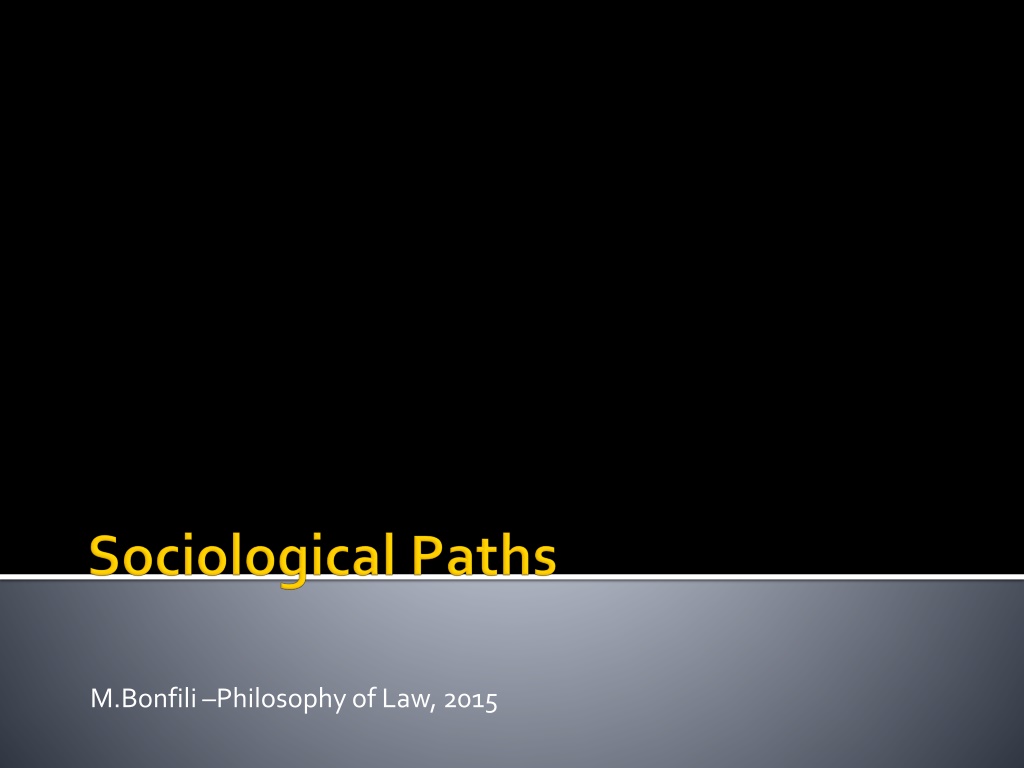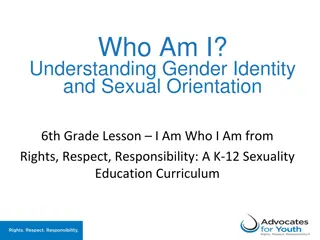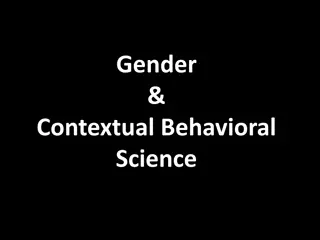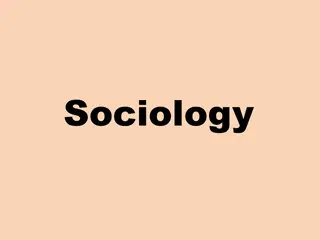Understanding Gender Socialization Theories and Impact on Identity Formation
The discussion delves into the criticism of naturalistic paradigms in understanding gender identity, emphasizing the societal role in shaping individual perceptions. It explores three theories of gender socialization - Psychoanalytic theory, Social learning theory, and Cognitive developmental theory. The significance of social influencers like family and media, along with the concepts of observation, imitation, and reinforcement in shaping gender identity are highlighted.
Download Presentation

Please find below an Image/Link to download the presentation.
The content on the website is provided AS IS for your information and personal use only. It may not be sold, licensed, or shared on other websites without obtaining consent from the author. Download presentation by click this link. If you encounter any issues during the download, it is possible that the publisher has removed the file from their server.
E N D
Presentation Transcript
gender thematisations in the psychosexological and psychoanalytical field, to different extents, share the critique of: biological determinism that postulates the original aspect of nature and thesubordination of society essentialism, which claims anteriority, priority and exclusivity of sex with respect to gender deterministic-essentialist perspective considers irrelevant even the terminological sex/gender distinction
Criticize naturalistic paradigm Thematizepriority of social assumption of gender role for the perception of gender identity in relation to sex According to these theories: society significant influence on the perception of subjective identity
Three types of theories explain gender socialization: Psychoanalytic theory(Freud-emphasizes the unconscious processes involved in developing gender identity) Social learning theory Cognitive developmental theory
More straightforward than psychoanalytic: focus on observable events and their consequences rather than on unconscious motives and drives. Numerous social learning theories but share principles derived from behaviorismin psychology. emphasizes the importance of our social environment on our development A lot of what you learn for gender-identity is gained by watching your primary and secondary socialisers.
Primary socialisers(also known as Informal socialisingagents) include people such as family, and siblings Secondary socialisers(also known as formal socializing agents) include the media, law enforcers, and teachers
Albert Bandura(1986) The reason we act and behave the way we do has been explained in 4 simple ways: Imitation Identification Reinforcement Modelling
Social learning theory also suggests that children learn by observing and imitating the behavior of same-sex adults. This is simply copying behaviour and is the fastest type of learning in humans. A young girl learns what it means to be female by observing her mother, whereas a boy learns what it means to be male by observing his father. This behaviour may be imitated because it is seen as rewarding. Thus the rewards stop and the behaviour too ceases.
Not all behaviour is likely to be imitated. In order to imitate, children need the belief that they have the capacity to imitate a behaviour they have observed. They also need Reinforcement of that behaviour to keep them from extinguishing the learned behaviour. Reinforcement strengthens behaviour with positive consequences
This is direct learning Our behaviour is strengthened (repeated/not repeated) due to a particular response (i.e. reward/punishment) According to this perspective, children are reinforced both positively and negatively for gender appropriate and inappropriate behavior A young boy playing with dolls, for example, might be ignored by his father; the lack of attention serves as a negative reinforcement, so that the boy eventually stops playing with dolls altogether.
Or, parents might hug a young girl who cries the hug serving as a positive reinforcement thereby increasing the likelihood the girl will cry again in the future In this way, the theory suggests, boys and girls learn which behaviors are expected of them. Boys learn that playing with dolls is inappropriate ; girls learn that expressing emotion is consistent with being female.
An individual desires to be like a specific model or part of a social group because they possess qualities they view as rewarding, i.e. attractiveness or status. The child experiences a form of attachment to them and aspires to be like them. Unlike imitation, identification implies some form of relationship between the imitator and imitated.
Are children the passive recipients of socialization messages that the theory postulates? There is evidence that children seek out message from their environment rather than merely passively accept what models offer.
Cognitive theories of gender socialization offer a different perspective emphasizing the developmental nature of the socialization process, as well as the active role the child plays in the construction of his or her gender identity. Lawrence Kohlberg was one of the first to apply theories of cognitive development to gender identity. Children develop the stereotypic conceptions of gender from what they see and hear around them.
Kohlberg believed that once they achieve gender constancy-- the belief that their own gender is fixed and irreversible they positively value their gender identity and seek to behave only in ways that are congruent with that conception. Once children establish knowledge of their own gender, the reciprocal interplay between one's behavior (acting like a girl) and thoughts (I am a girl) leads to a stable gender identity, or in cognitive- developmental theory terms, the child achieves gender constancy.
Some discredit his theory by saying that children demonstrate gender-typed behavior as young as two or three years of age, long before they develop gender constancy
The Gender schema theory proposes that children learn from the culture in which they live a concept of what it means to be male and female. they internalize this pattern as a knowledge as a gender pattern that becomes the core of gender identity that interacts with individual experiences and is reinforced by the mechanisms of reward/punishment received based on behavior. gender schemas, help children organize information, and maintain a sense of consistency and predictability.
In your own childhood, as you struggled to comprehend the world, you like other children formed concepts, or schema, including a schema for your own gender. Gender then became a lens through which you viewed your experiences. Through language, dress, toys, and songs, social learning shapes gender schemas. Children then compare themselves with their concept of gender ("I am male - thus, masculine, strong, aggressive," or "I am female - therefore, feminine, sweet, and helpful") and adjust their behavior accordingly
tend to be polarized, so that children believe what is acceptable and appropriate for females is not acceptable or appropriate for males (and vice versa) tend to be androcentric; that is, children internalize the message that males and masculinity are the standard or norm, and are more highly valued than females and femininity (Wharton).
In other words, children adjust their behavior according to their gender norms and expectations. This theory states that the developing child internalizes gender lenses that are embedded in the discourse and social practices of the culture, and that these lenses predispose the individual to construct a self-identity that is consistent with these lenses Gender schema is essential in gender role development and it emerges in early childhood.
gender-stereotyped behaviors and attitudes may occur this ultimately leads to the androcentrism part of the Gender Schema theory which suggests that the standards are created from the male point of view, so everything different from this category is considered a deviation from the standard as well as an inferior departure.
Kohlbergfirstto apply theories of cognitive development to gender identity children s views of appropriate gender roles ...change as they grow older, reflecting their changing cognitive development once children develop gender constancy the recognition of themselves as male or female and the stable, unchanging nature of their gender they become more motivated to demonstrate gender appropriate behavior.
theory failed to explain why children use gender, rather than some other construct, to organize their view of the world
This theory posits that portions of an individual's knowledge acquisition can be directly related to observing others within the context of social interactions, experiences, and outside media influences. It is a learning theory based on the ideas that people learn by watching what others do and that human thought processes are central to understanding personality. People learn by observing others.
Learning is an internal process that may or may not change behavior. People behave in certain ways to reach goals. Behavior is self-directed (as opposed to the behaviorist thought that behavior is determined by environment.) Reinforcement and punishment have unpredictable and indirect effects on both behavior and learning
interpret socialization as an active process that is not reduced to mere passive internalization of external expectations, but presupposes and involves negotiation and modification. Children do not limit themselves to the perception of the gender messages from outside, but they interact with others building their own identity.
Interpret socialization as an active process that is not reduced to mere passive internalization of external expectations, but presupposes and involves negotitation and modification Children do not limit themselves to the perception of gender messages from outside, but they interact with others building their own identity
suggests that almost all behavioral differences we know about between males and females are result of cultural stereotypes about gender (how males and females are supposed to act) and the resulting social roles that are taught to young people
Gender stereotypes are the common beliefs about people based on the belonging to social categories They vary according to physical characteristics, psychological traits, behaviour and to tasks/ functions
has had a major impact in the philosophical debate on gender Critics essentialism Social constructionism is opposite to: biological essentialism thatrecognizes identity in essence social essentialism fixes single identity on a social level
The social construction of gender comes out of the general school of thought entitled social constructionism. Constructionismrefers to constructivism . Constructivism is a predominantly philosophical and epistemological theory according to which it is not possible to objectively represent reality, given that the sphere of our experience is the result of our constructive activity.
Constructionismis a sociological theory that applies the constructivist theory to society: believing that societyis the construction process through which people constantly createnot by means of their being, but by means of their acting and interacting, a common and shared reality, experienced as objective
Take, for example, money. Money is a socially constructed reality. Paper bills are worth nothing independent of the valueindividuals ascribe to them. The Euro is only worth as much as valueas Europeans are willing to ascribe to it. Note that the Euro only works in its own currency market; it holds no value in areas that don't use the Euro. Nevertheless, the Euro is extremely powerful within its own domain.
Constructionismdoes not investigate what people are but rather what they do together as part of the social relations in specific historical and cultural contexts
The key concepts of the constructionist theory are identified in the three phases of the process which, through action and interaction, allow subjective meanings to be transformed into objective facts and to construct sociallythereality.
The first phase is externalization: it is the moment in which the agents, through their activities, create the social dimensions. Then objectification : it is the phase in which individuals, through thought objectivise reality as, independentoftheindividual. and language, The last phase is internalization : it is the stage in which, through socialization, the order constructed subjectively and intersubjectively is accepted and objectively legitimized.
This theory has contributed to the social elaboration ofgender: starting from the not disputed fact that there are two sexes (man and woman) or sexed identities the gender category refers to the social process or socialization (gendering process) but also to the product of this process, which divides peoplein societyinto male and female In this sense gender is not rooted into gendered beings,butin society(genderedsociety).
Social constructionism, affirms that the source of gender is not nature but history and human action/interactions Gender is no longer considered as a constitutive element of natural being or inherent essence, but it becomes a quality of social relationship. Gender is a human production that depends on everyone constantly doing gender Gender becomes, therefore, the construction of femininity and masculinity: it is an external creation, influenced by society and determined by culture.
The process of socialization, in this perspective, is composed by the association repeated in time between one sex (male/female) and certain social actions/practices (roles,responsabilities,expectations)
As a process gender creates the social differences that define woman and man . In social interaction throughout their lives, individuals learn what is expected, act and react in expected ways, and thus simultanously construct and mantain the gender order. In almost every encounter, human beings produce gender , behaving in the ways they learned were appropriate for their gender status, or resisting or rebeling against these norms.
This determines the association of the female with the reproductive and domestic role and the male with the economic and political role.
Hierarchicalisation may arise from opposition: in this sense, hierarchy does not come from natural distinction, but from the social construction associated with the natural distinction, insofar as society privileges one category, placing it in a position of superiority or exclusivity, and devaluing the other. Constructionismbelieves that people are not marginalized because they have different sex, but different because marginalized in relation to gender.
In societies that create the greatest gender difference, such as saudi arabia, women are kept out of sight behind walls or veils, have no civil rights and often create a cultural and emotional world of their own. But even in societies with less rigid boundaries, women and men spend much of their time with people of their own gender because of the way work and family are organized. This spatial separation of men and women reinforces gendered differences and ways of behaving.
It is a theory that is different from essentialism, as it states that man/woman differentitiation is also a social process, not only the direct expressionof nature; it criticizes the overlapping of sex and gender, and introduces a contrast between sex, the term fixes identity statically to nature and gender, whichflexibly indicates a process According to this theory gender varies from culturetoculture Changesformtimetotime
A number of different discourses construct and maintain gender identities and expectations. When we are being socialized: we have all these different levels of socialization from primary socialization and secondary socialization to everyday acts of maintenance that confirm and sometimes challenge our gendered worlds. So basically human beings are affiliated with a number of institutions and each institution has its own discourse they espouse, that help program our gendered outlook on the world.
So some examples of this would be religious discourse: People who are affiliated to different churches, these different worship places will expose their followers to gendered discourses that tell them the appropriate behavior of men and women. Like in a number of religious discourses women should defer to the judgment of men Also medical discourses, doctors also shape us our understanding of appropriate gender performances, legal discourse definitely come into play here: who should have what opportunity in the job force and then other discourses and institutions include education. Media discourses that help us understand the way man and women should look
Discourses make the normative appear natural. So in a lot of these discourses we try to make it seem like: this is the way it should be done , this makes gender appear as a natural construct rather than something socially constructed There isn t only one discourse but more discourses that model our gender.
The theorization of gender as a cultural constructionisalongthesamelines Also criticizes the essentialist claim that explains sex biologically as an innate, deep and unchanging uncontaminatedbyculturalinfluences character which is























